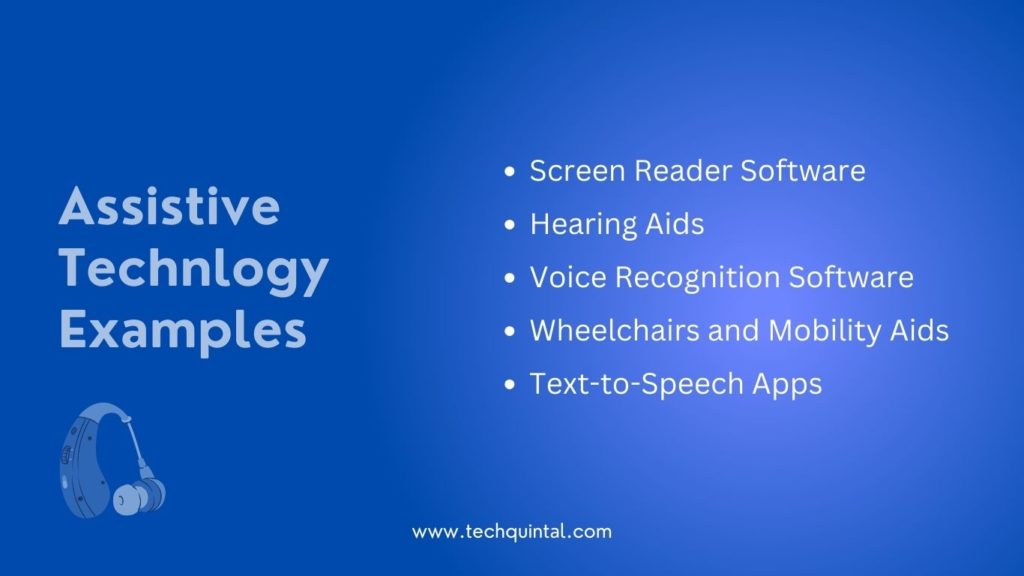
The primitive origins of assistive technology were tools such as casts, stretchers, sleds, splints, and the first forms of wheelchairs. They had one thing in common – helping differently-abled people live a somewhat normal life. Humankind later discovered ways to help with the loss of senses, primarily touch, hearing, and sight, as well as motor skills, and difficulties in learning, reading, or comprehension. And while they weren’t advanced, these solutions undoubtedly inspired modern forms of assistive technologies. With that said, let’s define the term assistive technology before helping you recognize it at work.
What is assistive technology?
Because we don’t feel like one does it justice, here are two definitions of assistive technology:
- Assistive technology is any item, product system, or piece of equipment, obtained off the shelf e.g., commercially, customized, or modified, that improves, increases, or maintains the functionality of individuals with disabilities.
- Assistive technology represents items, equipment, product systems, or services developed to improve or maintain functioning in differently-abled people and allow them to perform activities that might otherwise be difficult or impossible.
Why is assistive technology important?
Assistive technology helps people with disabilities. It supports them while allowing them to enjoy much more independence, privacy, and dignity. It even helps them save some money and allows them to be the masters of their lives and decisions.
Assistive technology is important to our society as a whole and also to those who require it individually. As a school, there are many reasons why we must promote it and allow it to reach those in need. These are the reasons why assistive technology is important:
- It helps people with disabilities lead a normal life.
- Helps them with their daily tasks.
- Allows them to read, write, and listen more effectively.
- Assistive technology also helps with communication.
- It can further be repurposed to aid body posture and body support.
- Allows people to be more mobile and pursue proper transportation.
- People with disabilities can also use assistive technology to enjoy culture and recreational activities.
- They can even modify their homes or work environments to create a more comfortable and practical setting.
- It can be used to replace missing body parts, allowing people to live a fulfilling life.
- Monitor the safety of a person 24/7.
- It can help foster a sense of control and dignity.
- Helps reduce the burden on caregivers.
- And reduces accidents and falls.
Assistive technology is improving the quality of life for many, and it generally does so in four steps. Learn more about these steps and assistive technology in the following video:
What are the challenges assistive technology faces?
Despite being beneficial, assistive technology is not readily adopted or even available for many. The WHO even expresses concerns, as it has estimated that almost 2.5 billion people in the world require proper access to assistive technology, a number that will only rise to 3.5 billion by the end of 2050.
Yet, there are challenges and barriers that prevent the widespread application of assistive technology. These are the challenges faced by assistive technology:
- It is generally costly for an average person without proper financial means to access assistive technology.
- Furthermore, it is not always readily available, and the quality varies from place to place.
- There are also socio-economic issues surrounding the tech that affect its production and supply.
- And even if it is available, many healthcare providers lack the necessary training to apply it.
- Even people who are in need of this tech are often unaware of its existence.
It is not like administrations and governments are not aware of these issues, as many are actively trying to circumvent them and bring assistive technology to as many people as possible. Even organizations such as WHO and UNICEF are trying to bring quality devices and solutions to those in need, as expressed in the following video:
Examples of assistive technology

Instead of the type of disability, we sorted assistive technology examples by their type:
1. Devices
The following are some examples of assistive devices:
1.1 – Wheelchairs and scooters
Wheelchairs and mobility scooters aren’t vehicles according to law. They’re classified as adaptive equipment, e.g., devices that assist tasks related to daily living. With that said, wheelchairs used to be (and still are, to a degree) propelled by the user or another person.
Nowadays, the dominant form, shared with scooters, is motorized wheelchairs. They use an electric motor, a battery with a large capacity and efficiency, and rely on laws of mechanics to generate additional power. They’re hands-free and controlled by a joystick, or, in some cases, by the occupant’s mouth (“sip-and-puff controller”). Researchers even produced mind-controlled wheelchairs, but they are yet to enter commercial space.
1.2 – Hearing assistance
Hearing aids used to be the primary personal amplification devices but now we have affordable and minimally invasive Cochlear implants. Furthermore, hearing-impaired persons can use vibrating alarm clocks, light-flashing doorbells, or devices for real-time closed captioning (CC) generation, in multiple languages.
At present, the numbers of amplified telephones, TTYs e.g., text telephones for the deaf, and video communication devices that allow two-sided sign-language on-screen, are shrinking thanks to smart devices. Face-to-face communication devices, which can record and alter sound volume, clarity, tempo, and pitch, are another example.
1.3 – Artificial limbs
A prosthesis or a prosthetic implant is an artificial device whose purpose is to replace a missing limb. They used to be quite basic and static in the past, acting as “placeholders”. The advancements in computer-aided design (CAD), electronics, mechanical linkage planning, and medical technology have made vast improvements since then.
Prostheses make users expend far less of their energy by using lightweight materials such as carbon fiber. Their functionality is also aided by microprocessors, electromotors, or hydraulics. Bionic limbs, which rely on interpreting signals from the individual’s muscles or electrical signals from nerves and the brain, are becoming more available too.
2. Computer software and hardware
Assistive computer software doesn’t necessarily need to run on specialized computer hardware nowadays. Today’s hardware manufacturers put a lot of effort into making their products disability-friendly. Now, let’s list a few examples:
2.1 – Speech-to-text
Voice recognition, in its most common form, speech-to-text conversion, is heavily assisted by Artificial Intelligence and machine learning. It allows differently-abled people, particularly those who are sight or mobility-impaired, to use a computer and home appliances. They can write notes, communicate with others, use the Internet search and social media, set up reminders, get traffic and weather information, and much more.
2.2 – Text-to-speech
The most common example of text-to-speech technology is a screen reader, whether within dedicated devices and systems or as part of mainstream operating systems. They benefit speech-impaired people with physical problems with, for example, vocal cords or the larynx, or mental conditions such as stuttering.
Moreover, machine learning and AI have brought features such as word prediction and real-time spell-checking and editing. The software can also adjust results based on the intended use and required vocal effects.
2.3 – Screen magnification
Screen enlargement software, intended for those with low vision, allows the user to zoom the contents of the screen (text or graphics) relative to the rest of the screen, usually with a maximum of 36 to 60 times. The software is oftentimes combined with screen readers, display settings (color scheme, brightness, transparency, contrast, etc.), and use of speech-to-text or gesture functionality.
3. Tools
Assistive tools or adaptive tools are almost exclusively used by disabled people. Some notable examples that assist with motor coordination issues include book holders, automatic page-turners, pencil holders, self-balancing pans, utensils, and bookstands, and adaptive switches.
Assistive technologies and their benefits
Here are a few assistive technologies and their benefits:
| Technology | Description | Benefit |
|---|---|---|
| Screen Readers | Software that can read any text displayed on the screen | Helps those with vision impairments use devices effectively. |
| Hearing Aids | A device that can amplify and clarify sound | It improves the hearing ability of a person with similar difficulties |
| Wheelchairs | A chair with wheels that can help with mobility | Allows people with mobility issues to gain some independence and access to transportation |
| Voice Recognition | Software that can change voice to text | Helps people with physical disabilities and with communication |
| Cognitive Apps | Apps that help with memory, organizing, and other mental faculties | Trains the brain, and those with cognitive impairments in daily tasks |
| Adjustable desks | A desk that can be adjusted to various heights | Helps improve body posture and support |
Application of assistive technology
Here are a few prominent uses of assistive technology:
Quality of life improvements
Before the widespread application of assistive technology, society often excluded or isolated individuals with disabilities and the elderly. They struggled with financial support, inescapable medical bills, deteriorating physical state, and lack of education and employment opportunities.
Assistive technology allows them to live and function independently or with a greatly reduced need for help. They can have an active social life, enjoy hobbies, get faster and better medical care, feel drastically less psychically distressed, and enjoy a prolonged, happier life.
Better education
We have already analyzed ways technology helps differently-abled students, and you’ll find many of the examples above on the list. Like with able-bodied people’s lives, the application of modern technology in education has had a massive effect on both teachers and students who are differently-abled.
Breaking the employment barrier
According to groups polled in a 2006 study, disability was the primary barrier to their employment. Fast-forward to today, and differently-abled people can (some for the first time) voice their concerns and give their opinions. Specialized hardware and software are more widespread, and there are adjustments in office space, devices, tools, and services.
Additionally, government grants and regulations, especially regarding occupational health, are more prominent and better applied. Combined, these elements led to increased job recruitment, accommodation, and retention levels for the differently-abled.
What to expect from Assistive Technology in the future?
As we progress further in our technological advancements, it is more likely that we will see new applications and innovations in assistive technology. Many experts have even made a few suggestions that they believe are likely to be possible in the near future.
Things like autonomous wheelchairs, brain-controlled hearing aids, and emotion monitoring devices are soon likely to be the norm, alleviating the various challenges faced by a person with special needs. Thus, let us take a look at what the future holds for assistive technology:
- The future will see a rise in built-environment domains such as smart homes and cities.
- Emphasis is also given to cognitive tech for self-care and personal environmental needs, including smart medication management and AI-based healthcare assistants.
- Communication will see an overhaul as brain-controlled interfaces will make an entrance.
- Technology is also expected to improve hearing aids or present an alternative to traditional devices in favor of non-invasive bone conduction-based hearing aids and invasive practices such as implants that can connect to the brain directly.
- Smart eyeglasses and eyewear will be available sooner than expected and can assist the visually impaired by providing computer-assisted vision.
- And finally, there will be further improvements to prosthetics and other mobility support technologies.